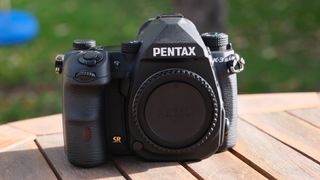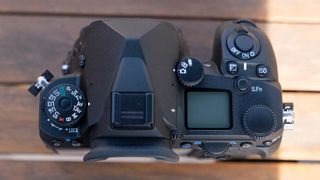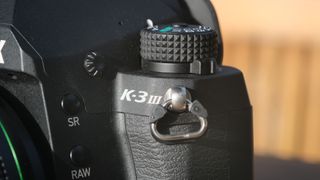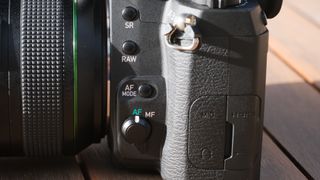Tom's Guide Verdict
Pentax fans and DSLR enthusiasts will find lots to love about the K-3 III, but its combination of high price and some outdated features prevent it challenging the best mirrorless cameras.
Pros
- +
Stellar image quality
- +
Excellent image stabilization
- +
Excellent build and handling
- +
Plenty of controls
- +
Great battery life
Cons
- -
No flip-out LCD
- -
4K video is cropped
- -
Autofocus struggles in some scenarios
- -
High price
Why you can trust Tom's Guide
Sensor: 25.7MP APS-C CMOS
Image stabilization: 5-axis in-body image stabilization
AF points: 101/25 cross-type, contrast AF in live view
Viewfinder: Optical pentaprism, 100% coverage, 1.05x magnification
Display: Fixed 3.2-inch touchscreen, 1,620k dots
ISO: 100-1,600,000
Max video resolution: 4K (cropped) @ 30 fps; FHD @ 60fps
Ports: 2x SD, HDMI, USB, stereo mic and headphone jacks
Wireless/Bluetooth: Yes
Shooting speed: up to 12 fps (37 JPEGs/32 RAW)
Battery life (CIPA): 800 shots
Size/weight (body): 134.5 x 103.5 x 73.5mm / 735g
The Pentax K-3 III is an excellent DSLR born into a world that no longer cares much about DSLRs. In fact, with most people happy to snap away with one of the best camera phones and even enthusiasts having now switched to the best mirrorless cameras, it’s a surprise it even exists.
But here it is nonetheless, an APS-C DSLR that proves Pentax is standing by its assertion that it “believes in the future of SLR photography,” despite the fact that neither Canon nor Nikon has released one in two years.
None of that should count against the K-3 III of course, which taken on its own merits is a very good example of a dying breed. But equally, it’s impossible not to consider whether there’s actually a market for it outside of Pentax enthusiasts.
Let’s put all that aside for a moment, though, and talk about what it offers. That’s actually quite a long list, including a new 25.7-megapixel sensor, new processor, new 101-point autofocus system, 5-axis image stabilization, 12fps burst shooting, 4K video and USB charging.
- Best photo editing software
- Save your images in the cloud with the best photo storage and sharing sites
I spent several weeks with it, and enjoyed shooting with it despite its drawbacks. In fact, I'd say it's one of the best DSLRs. Find out what it gets right, and wrong, in our full Pentax K-3 III review.
Pentax K-3 III review: Price and availability
The Pentax K-3 III costs $1,995 in body-only form and is also available with a variety of kit lenses. Among them are the 11-18mm f/2.8 lens I tested it with ($3,399), the 55-300mm f/4.5-6.3 ($2,349) and the 16-85mm f/3.5-5.6 ($2,449). There’s also a battery grip, which costs $295. The Pentax K-3 III is available now.
We don’t expect any discounts on it so soon after its release, but you never know, so bookmark our Black Friday camera deals page to be sure.
Pentax K-3 III review: Design

There are no design surprises with the Pentax K-3 III: it’s a DSLR, it’s proud of it, and it sure as hell isn’t going to take any risks. But while there’s nothing particularly wrong with its looks, as far as DSLRs go, it suffers from the format’s familiar drawbacks.
To that end, it’s a fairly big and bulky camera, although it is smaller than the K-3 II. You certainly won’t be fitting it in your pocket unless you’re dressed as a clown for the day. It’s also quite heavy, particularly when teamed with the chunky 11-16mm lens I used for my testing; strap it round your neck for more than an hour or two and you’ll notice it.
The biggest flaw here, though, is that the 3.2-inch LCD touchscreen doesn’t flip out as most now do. Come on, Pentax — I know making a DSLR in 2021 is something of a throwback, but that doesn’t mean you can’t move with the times.
On the plus side, it’s extremely well built. It’s crafted from magnesium alloy and is fully dust- and weatherproof; it’s certainly tougher and better able to handle the British weather than I am.

It also feels great, with a nicely rounded grip that offers plenty of purchase, and the multitude of manual controls are mostly accessible with the thumb or forefinger through feel alone. Dual SD card slots are another bonus, as is the top status panel.
And then there’s the optical viewfinder, which is big and bright with a 100% field of view and 1.05x magnification. Electronic viewfinders, as found in most mirrorless cameras, have improved a lot in recent years and have some advantages — but there’s still no beating an optical one for clarity.
Overall, there’s plenty here to like, and while it may lack the retro stylings of some mirrorless rivals, it’s a nice camera to shoot with.
Pentax K-3 III review: Controls

The Pentax K-3 III gets a lot right with its controls. For starters, there are plenty of them — I counted a staggering 29 buttons or dials spread across the top, back and sides of the camera. This could be overwhelming for some, but then again the majority of people buying the K-3 III will probably have used a DSLR before. Many of the controls are also customizable, so you’ll be able to set it up exactly as you want.

The main mode dial is on the top left and has a lock below it to prevent accidental changes. As well as the usual modes you also get Pentax’s TAV option, which lets you control aperture and shutter speed via the two control dials.
Round the back, there’s a nice little joystick for choosing focus points, while an AF button on the left-hand-side lets you flip between the various autofocus modes. But my favorite control (yes, I have one) is the green button; this resets settings to default and is a great little touch.
Pentax K-3 III review: Performance
Autofocus is handled by a new 101-point SAFOX 13 AF system, but though it does a good job in some situations, it’s one area where the K-3 III lags behind its mirrorless rivals; it certainly doesn’t compare to the likes of the Fujifilm X-T4 or Sony a6600.
That’s partly due to coverage: 101 points might sound like a lot, but the X-T4 has 425 and the a6600 has 850. What’s more, only 25 of those are faster cross-type points and they all sit in the center. Plus, the autofocus points don’t extend across the full width or height of the frame, meaning there are some areas where they simply won’t work. Though it does have continuous AF and subject tracking, it struggles to keep up if the subject moves out of the frame. The situation is worse still if you’re using Live View, which only has outdated contrast-detection AF.

What all this means in practice is that the K-3 III handles still subjects excellently, snapping on quickly and accurately, but it isn’t the best when it comes to fast-moving action such as sports. I certainly had mixed results when taking photos of my energetic labrador puppy. The above image (which has been cropped in) illustrates this — it's caught him mid-bound, but the focus is soft.

On the other hand, the K-3 III’s 5-axis image stabilization is excellent. Pentax claims it’s good for an extra 5.5 stops and that sounds about right from my experience; I was able to shoot as low as 1/8sec with some good results.
The K-3 III is also relatively fast, shooting at up to 12fps in burst mode, although the relatively small buffer (37 JPEGs, 32 RAW files) is a bit of a drawback.
Battery life is excellent — Pentax says it’s good for 800 images and I only needed to charge it a couple of times in my several weeks with it. Plus, you can charge it via USB-C, which is a bonus if you’re away from a plug as you can just use one of the best portable chargers and power banks.
Pentax K-3 III review: Image quality
The K-3 III teams a new back-illuminated 25.7MP APS-C CMOS sensor with a new PRIME V processor, and the combination makes for superb images in almost every situation. I used it extensively over sunny days and gloomy afternoons outside, and indoors under harsh lighting and it rarely made a wrong step.









Stills have masses of detail and are incredibly clean; you can shoot up to ISO 6400 without any concerns and even 25,600 is usable. That said, I wouldn’t recommend trying ISO 1,600,000, which makes it look like you’re using a filter called ‘colorful sand’.
Dynamic range is also impressive, with the Pentax K-3 III rendering blue skies without blowing out the highlights on a bright sunny day, and also picking up details in the shadows in more overcast conditions. Colors tend towards a more natural look, which can make them look muted compared to some, but you can easily ramp them up in the settings.
I shot the same scene with K-3 III and my beloved Fujifilm X-T3 and the results are quite stark. The X-T3 may be three years old, but it's still an excellent camera — but the K-3 III leaves it for dead in this comparison, doing a much better job at exposing the scene and serving up far more realistic colors.
Pentax K-3 III review: Video
Though the K-3 III can shoot 4K video, it’s definitely aimed more at stills shooters. The first problem is that video is only via live view, and that mode is hamstrung with slower contrast-detection AF. Plus, although there is a continuous autofocus option, it’s only available with certain lenses (of which mine wasn’t one).
What’s more, 4K footage (at 30/24fps) is only available via a cropped mode, too, so you’re probably better off with 1080p (at up to 60fps). And because the screen can’t flip out, you end up having to hold the heavy body up in front of you in order to see what’s going on.
But while it’s hardly going to trouble the best vlogging cameras, it’s perfectly serviceable for family videos. Footage is clear and colorful and the image stabilization really helps to keep things steady. In short, it’ll do the job for stills shooters who occasionally take videos, but not much more.
Pentax K-3 III review: Features
Pentax has long had fans in the star-gazing community, thanks to its dedicated Astrotracer feature, which shifts the sensor as you shoot the heavens so that stars remain static even as the Earth rotates. Having used it on the K-3 II, I expected it to be in the new model, but while it is, there’s no built-in GPS as there was in its predecessor. The upshot of that is that amateur astronomers will need to buy the separate O-GPS-1 attachment ($195) to take advantage of it.
The K-3 III does have built-in Wi-Fi and Bluetooth for easy connection to a phone, but unfortunately the Android version of its Image Sync app has been removed from the Play Store at the time of writing, so I was unable to try it.
Pentax K-3 III review: Verdict

If the Pentax K-3 III had come out five years ago, it would have been one of the best cameras available at its price point. As it is, it will have to settle for being one of the last great DSLRs.
If you’re a long-time Pentax user, it comes highly recommended. Image quality is superb and it’s well built, with plenty of nice little touches that make it a pleasure to shoot with — though the absence of GPS for the Astrotracer function is annoying, and the price is on the steep side.
That $1,995 price also counts against it when compared to several older DSLRs. The excellent Canon EOS 90D is available for less than half that, and shoots uncropped 4K video; Nikon’s D780 is slightly cheaper and has a full-frame sensor (and full-width 4K to boot).
However, most people will instead be better off with a similarly priced mirrorless camera such as the Fujifilm X-T4 or Nikon Z6 II, both of which are smaller, lighter, faster and offer better autofocus.
Ultimately, while the K-3 III takes beautiful photos, it doesn’t do quite enough to justify that high price — or to explain why Pentax is sticking with DSLRs as the rest of the world moves on.
Formerly Editor in Chief (U.K.) on Tom’s Guide, Marc oversaw all gaming, streaming, audio, TV, entertainment, how-to and cameras coverage, and was also responsible for the site’s U.K.-focused output. He is now U.K. Editor in Chief on TechRadar. Marc previously edited the tech website Stuff and has tested and written about phones, tablets, wearables, streaming boxes, smart home devices, Bluetooth speakers, headphones, games, TVs, cameras and much more. He also spent years on a music magazine, where his duties mainly involved spoiling other people’s fun, and on a car magazine. An avid photographer, he likes nothing better than taking pictures of very small things (bugs, his daughters) or very big things (distant galaxies). When he gets time, he also enjoys gaming (console and mobile), cycling and attempting to watch as much sport as any human can. He's also fallen in love with Wordle over the past six months and is the author of our today's Wordle answer column, in which he supplies hints and strategy tips for the mega-popular word game. Given he's completed every single Wordle so far and only lost once, and analyzed every Wordle answer in search of patterns, he's well qualified to help you safeguard your streak.

